
Senecio is a genus of flowering plants in the daisy family (Asteraceae) that includes ragworts and groundsels.

Ageratina, commonly known as snakeroot, is a genus of more than 330 perennials and rounded shrubs in the family Asteraceae.
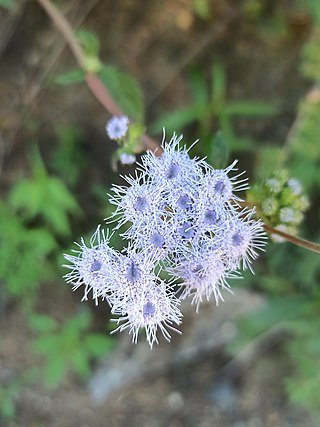
Ageratum is a genus of 40 to 60 tropical and warm temperate flowering annuals and perennials from the family Asteraceae, tribe Eupatorieae. Most species are native to Central America and Mexico but four are native to the United States.

The Heliantheae are the third-largest tribe in the sunflower family (Asteraceae). With some 190 genera and nearly 2500 recognized species, only the tribes Senecioneae and Astereae are larger. The name is derived from the genus Helianthus, which is Greek for sun flower. Most genera and species are found in North America and South America. A few genera are pantropical.
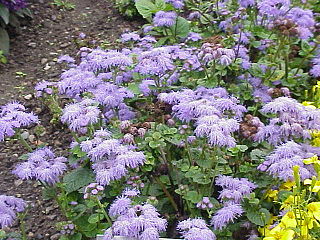
Eupatorieae is a tribe of over 2000 species of plants in the family Asteraceae. Most of the species are native to tropical, subtropical, and warm temperate areas of the Americas, but some are found elsewhere. Well-known members are Stevia rebaudiana, a number of medicinal plants (Eupatorium), and a variety of late summer to autumn blooming garden flowers, including Ageratum (flossflower), Conoclinium (mistflower), and Liatris.
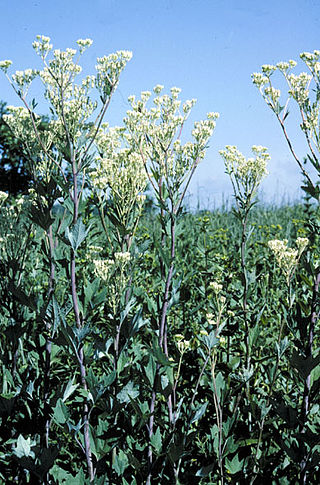
Arnoglossum is a North American genus of plants in the family Asteraceae, described as a genus in 1817. They have the common name Indian plantain because they resemble the unrelated common plantain.

Aequatorium is a genus of flowering plants in the aster family. It was described as a genus in 1978. It is a member of the tribe Senecioneae and native to South America.

Bartlettina is a genus of flowering plants in the family Asteraceae. They are native to tropical regions of Mesoamerica and South America. The genus was erected to house several plants separated from genus Eupatorium.

Distephanus is a genus of flowering plants in the family Asteraceae. It is described by American botanist Harold E. Robinson as having over 40 species and by David Mabberley as having only 34 species. These sources differ sharply in their description of the range of the genus. Robinson has it ranging throughout Africa and occurring also in India and China. Mabberley has it restricted to southeast Africa, Madagascar, and Mauritius.

Liabum is a genus of South American flowering plants in tribe Liabeae of the family Asteraceae.

Munnozia is a genus of flowering plants in the family Asteraceae. It is centered in the Andes.

Pentacalia is a genus of flowering plants in the family Asteraceae. About 34 members of this genus appear to be located in the South American county Ecuador, where they are threatened by habitat loss. The genus contains approximately two hundred species, which are distributed from Mexico to northern South America.
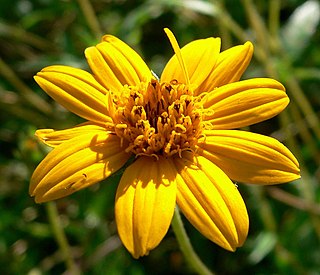
Wedelia is a genus of flowering plants in the family Asteraceae. They are one of the genera commonly called "creeping-oxeyes".

Paul Carpenter Standley was an American botanist known for his work on neotropical plants.
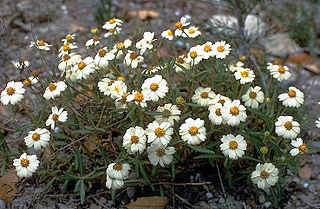
Millerieae is a tribe of flowering plants belonging to the Asteroideae subfamily. Of all the genera, only Galinsoga, Guizotia, and Sigesbeckia have species native to the Old World.

Psacalium is a genus of flowering plants in the sunflower family. Indianbush is a common name for Psacalium.

Lipochaeta, common name nehe, is a genus of flowering plants in the family Asteraceae that is endemic to Hawaii.

Melanthera, is a genus of perennial flowering plants in the family Asteraceae, native to North and South America, as well as Africa, Asia and Oceania, including Hawaiʻi.

Cyanthillium cinereum is a species of perennial plants in the sunflower family. The species is native to tropical Africa and to tropical Asia and has become naturalized in Australia, Mesoamerica, tropical South America, the West Indies, and the US State of Florida.

Vernonanthura is a genus of Neotropical plants in the tribe Vernonieae within the family Asteraceae.



















